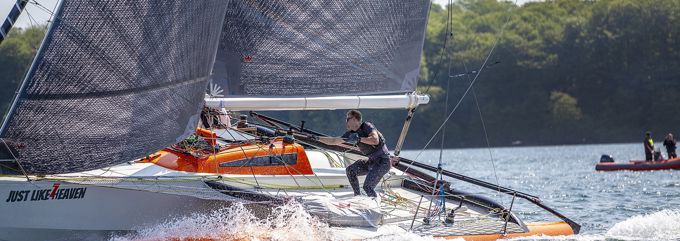
Sailors do sometimes need a new project – and that is exactly what “Just Like 7th Heaven” has become in the capable hands of Peter Bolvig and Bo Hasseriis. The two Copenhagen-based racers have known each other for many years – and raced in just as many classes, though mainly in the X99’s.
Their combined experiences also include the world of multihulls, and this ended up becoming their call for a very orange and indeed rapid new adventure.
The duo set their sights on the Seacart 30 – a brainchild of the Swedish firm Marström Composite AB in the early 00’s, and more importantly, it is one of few production boats made in an autoclave, and thus mostly from carbon fibre.
This made it super light – and the whole philosophy of the Swedish featherweight was the ideal match for what Bolvig and Hasseriis had in mind.
Our boat is a Seacart 30 made in 2006. Back then, it was an attempt from Marström Composite AB to create a trimaran for One Class-racing. What we were more interested in, however, was its construction.
A Seacart is special in terms of material choices and the way it’s made, and this ended up sealing the deal for the Copenhagen-based crew:
The Seacart is pretty special, as it is made almost entirely from carbon fibre, it makes it super light and yet very sturdy. This means that we have a racer today weighing in at around 950 kg without sails – and no matter what you throw at it, it just handles it, Bo Hasseriis says.
The whole adventure caught on in early 2021. The duo had decided what they wanted and basically just waited for the right offer to be listed. It happened in the Netherlands, and following the purchase, the Danish duo set to work taking it all apart.
The Seacart has been through an extensive process with countless new and upgraded parts. The Seacart itself was sanded and painted over, and at the end of the process, it had lost somewhere in the region of 100 kilos, bringing it down into three figures on the scales.

Optimizing the wardrobe
Upgrades and modifications for doublehanded sailing aside, the Seacart also needed a new wardrobe – and the duo quickly headed one way:
Actually, we did not have much of a discussion regarding the sails. We have known Elvstrøm Sails and our local dealer Thomas Taatø for ages, and we have both used Elvstrøm Sails on many different boats over the years, so it felt very natural for us to continue. We had a good chat with our designer, Lars Thiellesen, and we had a fantastic design process.
The process led the crew to a different sail design than the one their Seacart used to run:
Our new wardrobe on Just Like 7th Heaven differs in a few places from what we used to have. The top of our main has been revised, but the big difference is in the downwind setup. The code sails are flatter than before – giving us more sail area than before – but the shape ensures that it converts to added acceleration rather than more heeling, Bo Hasseriis says.
And since the nature of the project is so bespoke, it also meant a great deal for Peter Bolvig and Bo Hasseriis to be able to discuss the solutions and optimize as much as they could.
We are both extremely happy that we could discuss the solutions in detail. Lars and Thomas have been absolutely amazing to work with, and the sum of our dialogue was really worth a lot – throughout the design and build as well as afterwards. Lars still joins in with a tip or two if he sees something we could optimize in our handling. This also leads quite nicely to the charm of racing a multihull. When you manage to optimize this, it really picks up speed in a way no other sailing boat does it. It feels so satisfying to see all the small details coming together the way they do.

Sjælland Rundt – making the most of changing conditions
Combining a setup made for double handed racing and high speed despite low-wind conditions, Just Like 7th Heaven had a strong race at the recent edition of Sjælland Rundt. With several super calm sections in the traditional round-Zealand race, everybody faced a tough challenge.
This included Bo and Peter despite having the right gear for the job.
Sjælland Rundt was so tough. We started last, but we held a decent pace early one thanks to the big Code. As soon as it was up, we raced along at some 15 to 18 knots and it actually was quite a nice start for us. Then, four hours in, it all stopped and the wind disappeared.
The wind returned, and the duo then regained their advantage:
Eventually, we got it going again, and this turned out to be the theme of the race – making sure to keep moving. It is quite a task, though, as a trimaran is hard to keep going when the wind is so limited. It does however pick up speed very quickly as soon as you find even a small gust of wind.
A lack of wind also took a big bite of the averages for the race – but the duo made their way through it and won the Multihull class.
The wind went multiple times – but we ended up finishing the race. It is however very clear that all the periods of calm took a big bite of everyone’s average speeds. In our case, we were at an average of around six knots, which was almost half what we usually would get, Bo Hasseriis ends.